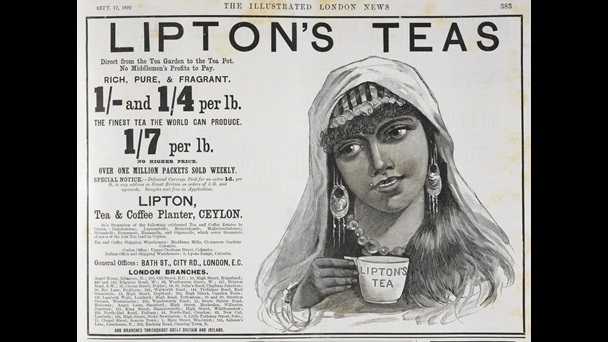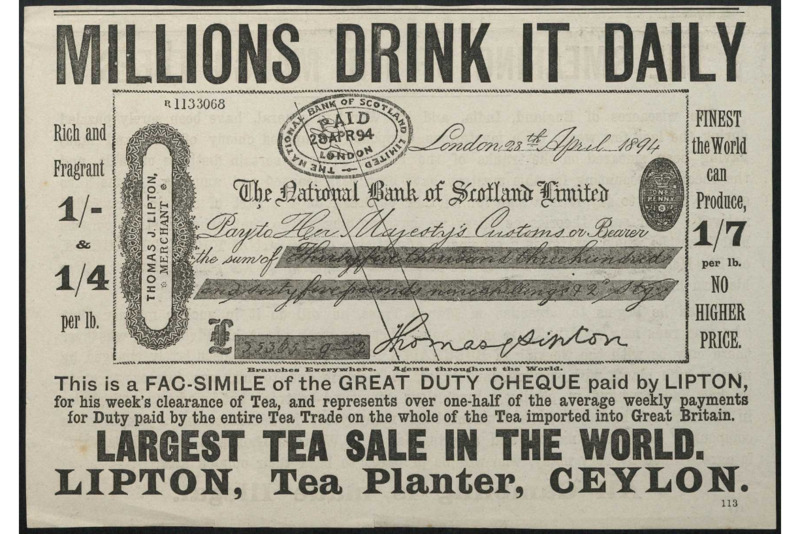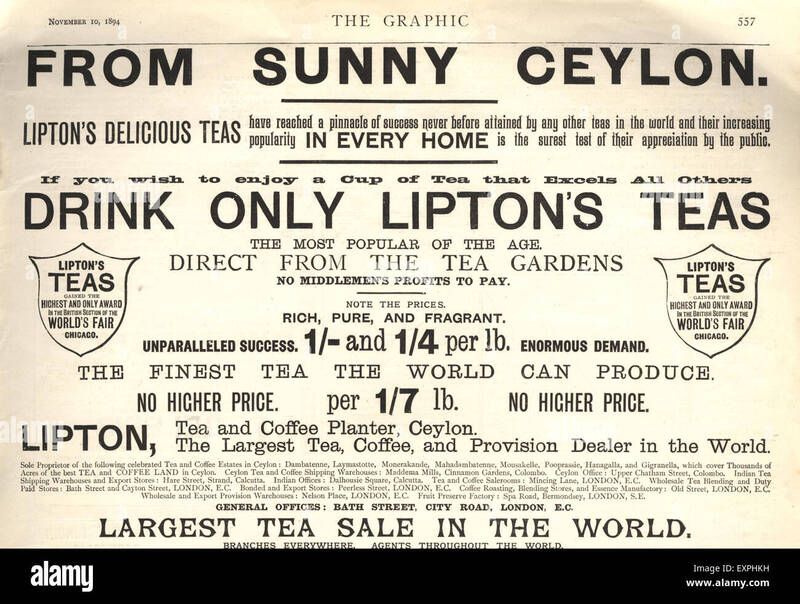Lipton’s New Ways of Advertising and Producing
With an implication of a new and confident style of advertising Sir Thomas Lipton was able to drastically expand the tea market and greatly profit from it. Many advertisements from that period of time depicted foreign people and laborers as exotic, unknown and new to the Britain tea market and put crucial focus on symbolizing the tea export from Sri Lanka as a direct and newly effective way to enjoy a fresh cup of tea (Ramamurthy, 2012). The movement of cutting out the middlemen of the market chain was also a huge economic move which had different effects. For example, Shops were selling loose leaf tea for the equivalent of 50 cents a pound, an amount he knew was beyond the means of a working-class family living on $10 per week. Lipton saw an opening: Why not cut out the middleman? (Koehler, 2016). By growing its own tea in Sri Lanka, Lipton was cutting out the London tea auctions and the middle men. This scheme, and his trademark slogan, “Direct from the Tea Gardens to the Teapot,” allowed a larger profit margin on his growing tea sales.
As this advertisement suggests the company was rapidly growing and a new way of business in Sri Lanka and exotic approach to tea, straight from tea gardens in Sri Lanka to your cup. Drinking tea was still expensive for the average working-class family. After investigating the tea trade in London, Thomas Lipton decided to cut out the middleman and lower the price to his customers. Prior to Lipton, tea was sold in groceries straight out of large tea chests, by weighing out a specified requested amount for each customer. Lipton changed that by introducing a standardized suite of packages selling huge amounts of tea in pound, half-pound, and quarter-pound packets (Mills, 2015). Before, chests of loose, blended tea were delivered to retailers, who opened them to make packets for their customers. The chests were neither air tight nor waterproof, and tea imperfectly stored for any length of time was subject to rot and mold. But even when a customer got what appeared to be dry and fresh, some chests contained mixed moldy leaves (D'Antonio, 2010). Lipton was revolutionary and his smaller packaging helped to sell more tea leaves more efficiently.
When asked, “Whats the secrets of your success?” Lipton replied, “Secret of it? Make no secret of it. Advertise all you can.” (D'Antonio, 2010). Advertising was a crucial part of Lipton’s success.
Advertisement from 1894, published at the University of London. Clearly tries to highlight the power of Lipton’s tea in Britain. With phrases such as: “Largest tea sale in the world,” or “Millions Drink it Daily,” in this case advertisement shows a facsimile of the cheque paid by Lipton for the tea trade. Certainly an unique advertisement with big phrases and explanations of how they sell tea by parts of pounds, in smaller quantities than it was usual in that time tea market. Lipton was a showman, and his commercial and bold marketing drove his success. Koehler in his article points out that, Sir Thomas Lipton was a master of memorable stunts, in his early years, he had pigs parade through the streets of Glasgow to his shop and even for a period of time, printed Lipton Currency Notes (Koehler, 2016). Lipton applied a new and unique way of advertising his tea business, and it certainly paid off.
Unique and aggressive style of marketing. Exotic feel, the best tea out there, and the customer should only drink Lipton’s tea because they are the best. The Queen even drinks their tea and they have the best prices! Just a few examples of more phrases that were straightforward and had different approaches, which seemed to work.



